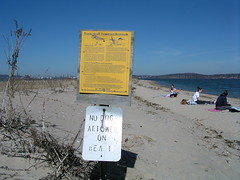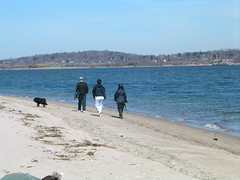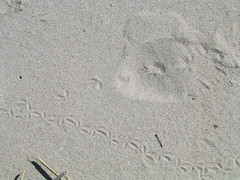Sandy Point's Threatened Birds
"The favorite bedding-ground then, as now, was 'The Beach', a sand-spit running off into the harbor for more than a mile from the Orange (western) shore. This is bare to a great extent at low tide, but covered everywhere at high tide, and is the best possible place for its purpose."

The oysters planted near The Beach were so valuable that 20 or more watchmen were hired to guard the oysters round the clock, and a watchtower was erected to give the guards a better vantage point (there also were watchtowers at Long Wharf, Lighthouse Point and Branford Harbor). The oystermen marked their oyster beds by sticking tree branches and limbs into the water – so many limbs and branches, in fact, that one visitor noted that the harbor looked like a submerged forest.
Sandy Point seems to be the favored name now (and it no longer is covered at high tide). The beach is owned by the city of West Haven. I went to there yesterday to look for birds and to see for myself about a couple of complaints that not enough was being done to protect piping plovers and least terns, two federally-threatened species that nest at Sandy Point. Oyster shells littered the beach and a couple of American oystercatchers flew in over the salt marsh, but the only other sign that the area was rich in oysters were prominently displayed posters indicating that the oyster beds were contaminated and that shellfishing was prohibited.
I first heard about Sandy Point and its plovers and terns last weekend at Audubon Connecticut's get-together in Greenwich. Two New Haven-area birders were concerned enough to mention it to me, and Patrick Comins, Audubon Connecticut’s director of bird conservation, sent me an information sheet that summarizes why Audubon named Sandy Point an important bird area. Over the past 20 years or so, an average of about 5 pairs of piping plovers have nested there; least terns, which nest colonially, have averaged 314 pairs.
When we got out of the car yesterday we remembered how different the weather at the shore is from the weather even a mile inland in April. The sun was strong enough to redden our faces but the wind blew steadily off the cold water. The tide was ebbing and we walked along a sandflat littered with shell fragments – oysters, angels toenails, quahogs, ribbed mussels, whelks. Far up the harbor, two big ships were docked, a blacked-hulled vessel called the Yangtze River and an orange-hulled vessel too far for me to make out the name. A line of gulls and waterfowl rested on a sand bar. A couple of people dozed in the dunes.

As we approached the point, I heard a quick piping sound and knew immediately that it was a piping plover. We saw two. I don’t think they had started nesting yet because they walked along the sand calmly, without engaging in the fake-broken-wing trick that they use to lure potential predators away from their nests. They were the color of wet sand, their faces pale and delicately marked with a couple of dark lines, as if sketched quickly and competently.
They seemed both vulnerable and tenacious. Piping plovers nest on only a handful of beaches along the Sound. Raccoons eat their eggs, dogs destroy their nests, people linger nearby long enough to keep the incubating parents away from the eggs. At Milford Point, which is part of the Stewart B. McKinney National Wildlife Refuge, a snow fence cuts off public access to the nesting area from April into the fall. The only other time I’ve ever seen piping plovers was during a visit to Griswold Point, at the mouth of the Connecticut River, 12 years ago with a naturalist from the Nature Conservancy. She showed me the circular enclosures she had erected around each nest, which let the plovers scoot in and out but kept raccoons and other animals away. At Sandy Point, the only safeguards were signs that said dogs were not allowed and another that requested that people leave the plovers and terns alone.

The terns don’t come back until May but we didn’t want to bother the plovers (plus we were cold), so we headed back soon after spotting them. On our way, we passed three people walking their dog. I was tempted to tell them about the no-dogs rule but I settled for photographing the dog, the sign that said no dogs allowed, and the delicate footprints the piping plovers left in the sand.

What should be done to protect federally-threatened species on a public beach? I’ve gone back and forth on this over the past week. My first answer was simple: do everything possible; erect a fence, post signs, patrol, and keep people off during nesting season. But then it occurred to me that I argue in my book and in my talks that the Sound needs a bigger and stronger constituency, which requires that people be able to get to the shore and to the water. What benefit would it be if the birds were protected but people were kept away?
But after visiting yesterday, and seeing the long strip of public beaches to the west of Sandy Point, I realize that there is no shortage of public access to the Sound in West Haven. Patrick Comins, of Audubon Connecticut, tells me that the city of West Haven seems willing to work on a solution and that Audubon will meet with city officials before the middle of summer to talk about it. Here’s a vote for fully protecting the birds and their nesting area on Sandy Point. The swimming and fishing and general recreation are close enough so that closing all or part of Sandy Point for several months should not be a cause for consternation.



0 Comments:
Post a Comment
<< Home